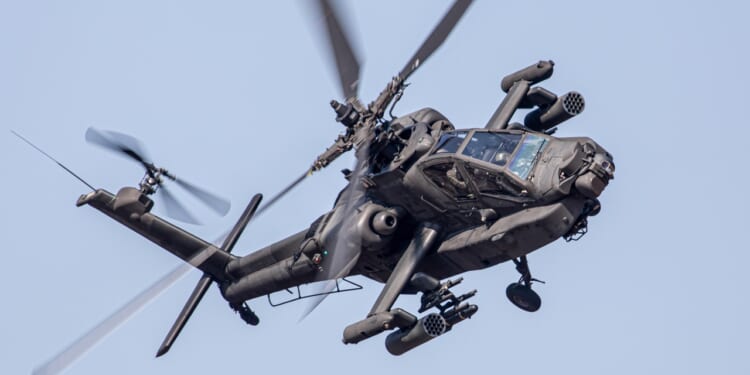Adapting “loyal wingman” drones to helicopters is a fundamentally different challenge than adopting them to planes, as helicopters are far slower and operate at significantly lower altitudes.
The United States Army is embracing the transformation being brought about by the revolution of drone warfare. The era of manned only rotary-wing and fixed-wing operations is yielding to a mixed manned/unmanned “team” structure. This is what’s known in the Air Force as the “Loyal Wingman” program, wherein the Air Force pairs a manned warplane with unmanned aerial vehicles.
Now the Army wants in. By enmeshing a “loyal wingman” drone with the Army’s robust helicopter force, Big Green thinks that these drones would help with air superiority, high-altitude strike, and low-altitude, close-in battlefield scenarios. Helicopters, assaulting from forward bases, would need adjuncts.
Why “Loyal Wingman” Drones Matter
This is crucial because any peer conflict will contest the skies, airspace control, intelligence/surveillance/reconnaissance (ISR), and logistical lines in contested terrain. The Army’s pivot signals that it doesn’t want to be left with only legacy manned helicopters vulnerable to anti-air, attrition, or denied zones. Besides, the Army needs a force multiplier: drones that fly alongside helicopters, take risks, extend reach, and provide “mass” cheaply.
Operating loyal wingmen drones alongside a helicopter is a fundamentally different game than pairing these drones with jets flying at 30,000 feet in the air. The Army needs different sensors from the Air Force, survivability features—radar-avoidance, terrain-masking—different communications technology, and artificial intelligence for close coordination.
To integrate unmanned systems, the software/human interface becomes essential. The Army’s “launched effects” program highlights this trend: smaller drones that are launched mid-flight, operate semi-autonomously. The leap to a full-sized Collaborative Combat Aircraft (CCA) drone is non-trivial.
Still, the advantage of unmanned wingmen is one of cost and risk. If CCA systems become as expensive as manned aircraft, the US military loses the economic edge—and thus the incentive to use them. The Army will need to shepherd development, so the drone doesn’t become a second helicopter in cost.
It’s Still Unclear Whether the Army’s Program Will Work
With this move, the Army is signaling that AI-domain control at the tactical level matters. In a future war, drones will accompany helicopters into littorals, fast-moving strike zones, forward operating bases—meaning even the “air cavalry” is evolving. For potential adversaries, this raises the bar: the Army fielding wingman drones means more nodes, more sensors, more distributed platforms, making targeting and suppression of Army aviation harder.
As it relates to the Army’s overall doctrine, the shift to manned/unmanned teaming (MUM-T) systems changes training, maintenance, logistics and tactics.
Of course, it’s all still too early. The Army might abandon this. Sure, there is a risk that the Army might duplicate that which the Air Force, Navy, and Marines are working on. But that doesn’t mean the Army shouldn’t investigate the technology on their own—especially considering how many young soldiers’ lives could be preserved.
The Army is stepping into the “loyal wingman” drone arena with its own twist—a system built for low-altitude, rotary-wing/assault environments, rather than high-altitude fighter operations. If executed well, this could provide the Army with greater mass, distributed platform capability, enhanced survivability, and more affordable risk platforms to accompany its helicopters and assault missions in contested spaces. Success depends on locking in the right requirements early for the design, managing cost/schedule, ensuring integration with existing aviation doctrine, and fielding a system that is durable, affordable, and interoperable.
As always, things will be determined better for how they “transition from concept to capability.”
About the Author: Brandon J. Weichert
Brandon J. Weichert is a senior national security editor at The National Interest. Recently, Weichert became the host of The National Security Hour on America Outloud News and iHeartRadio, where he discusses national security policy every Wednesday at 8pm Eastern. He is also a contributor at Popular Mechanics and has consulted regularly with various government institutions and private organizations on geopolitical issues. Weichert’s writings have appeared in multiple publications, including The Washington Times, National Review, The American Spectator, MSN, The Asia Times, and others. His books include Winning Space: How America Remains a Superpower, Biohacked: China’s Race to Control Life, and The Shadow War: Iran’s Quest for Supremacy. His newest book, A Disaster of Our Own Making: How the West Lost Ukraine is available for purchase wherever books are sold. He can be followed via Twitter @WeTheBrandon.
Image: Shutterstock / Daverse.

















